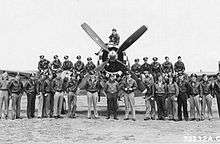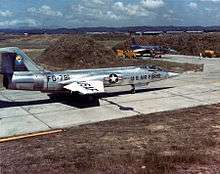83d Fighter Weapons Squadron
| 83d Fighter Weapons Squadron | |
|---|---|
|
Squadron F-106 at Loring Air Force Base in 1972 | |
| Active | 1942–1945; 1946-1969; 1971-1972; 1972-1977; 1991-present |
| Country | United States |
| Branch | United States Air Force |
| Type | Fighter Weapons |
| Insignia | |
| Patch with 83d Fighter Weapons Squadron emblem |
 |
The 83d Fighter Weapons Squadron is a United States Air Force unit, assigned to the 53rd Weapons Evaluation Group. It is stationed at Tyndall AFB, Florida.
Overview
The 83d Fighter Weapons Squadron is a non-flying unit that conducts the Air Force Air-to-Air Weapon System Evaluation Program. The squadron evaluates the total air-to-air weapons system including aircraft, weapon delivery system, weapon, aircrew, support equipment, technical data and maintenance actions. The squadron hosts 38 air-to-air WSEP deployments annually at Tyndall AFB.
The annual firing of 300 missiles evaluates all Air Force air-to-air missile capabilities for the AIM-120 Advanced Medium Range Air-to-Air Missile, AIM-7 Sparrow missile, AIM-9 Sidewinder missile and aircraft guns, and also provides live missile training for combat Air Force crews as a secondary objective. Squadron personnel verify weapon system performance, determine reliability, evaluate capability and limitations, identify deficiencies, recommend corrective action, and maintain Combat Air Force-wide data.
The squadron investigates missile envelopes and evaluates capabilities and limitations to determine future firing requirements. They provide liaison support for pre-deployment, employment, and redeployment of Air Combat Command, United States Air Forces Europe, Pacific Air Forces, Air National Guard, U.S. Air Force Reserve and Canadian Forces participating in WSEP, William Tell and WIC missile firing programs.
History
World War II

It was established in early 1942 as a IV Fighter Command squadron, and equipped with P-38 Lightnings. After training in California it was deployed overseas to the European Theater of Operations (ETO) in England. It was assigned to RAF Goxhill for European transition training with the Royal Air Force, and then assigned to its operational station at RAF Duxford. It was assigned to VIII Fighter Command for heavy bomber escort duties of B-17 Flying Fortress and B-24 Liberators, engaged in long range strategic bombardment of military and industrial targets in Occupied Europe and Nazi Germany. It engaged in air-to-air combat with Luftwaffe interceptors over France and the Low Countries; the extended range of the P-38 could not extend over Germany. It replaced P-38s with P-47 Thunderbolts in mid-1943; later with P-51D Mustangs in 1944 which enabled the squadron to fly escort missions deep into Germany and also engage in fighter sweeps over enemy airfields, bridges, railroads, road transport and other targets of opportunity. It continued combat operations until the German capitulation in May 1945.
The squadron demobilized in England during the summer of 1945, returned to the United States and was inactivated largely as a paper unit in October 1945. It was reactivated by the United States Air Forces in Europe in 1946 as an occupation unit at Army Air Force Station Straubing, Germany in 1946-1947.
Air Defense Command




The 83d was transferred from USAFE to Air Defense Command (ADC) in June 1947, and stationed at Mitchell Field, New York. Prior to being equipped it was transferred to Hamilton Air Force Base, California where it received F-51D Mustangs and F-84B Thunderjets. In the fall of 1950 it was upgraded to F-84Ds and in August 1951 it transitioned into F-89B Scorpions. In July 1952 the squadron moved to Paine Field, Washington and received F-86D Sabres. In August 1955 the 83d FIS designation was transferred back to Hamilton AFB to another F-86D squadron, and the organization at Paine Field was reassigned.
In December 1957 the 83d FIS received AIM-9 Sidewinder armed Lockheed F-l04A Starfighters and become the first operational F-104 squadron in ADC. In addition, the squadron received the two-seat, dual-control, combat trainer F-104B. The performance of the F-104B was almost identical to that of the F-104A, but the lower internal fuel capacity reduced its effective range considerably.
It was found that the F-104A was not very well suited for service as an interceptor. ADC released all its F-104s to the Air National Guard in 1960 because its fire control system was not sophisticated enough to operating in conjunction with the Semi-Automatic Ground Environment system to make it an all weather interceptor.[1][2]
Service with the F-104s consequently quite brief, and the Starfighters were replaced by more heavily armed all-weather McDonnell F-101B Voodoo in July 1960. The F-101B proved to be a quite successful interceptor. assigned alongside the F-101B interceptor was the F-101F operational and conversion trainer. The two-seat trainer version was equipped with dual controls, but carried the same armament as the F-101B and were fully combat-capable.
On 22 October 1962, before President John F. Kennedy told Americans that missiles were in place in Cuba, the squadron dispersed one third of its force, equipped with nuclear tipped missiles to Kingsley Field at the start of the Cuban Missile Crisis.[3] These planes returned to Hamilton after the crisis.
Although the number of ADC interceptor squadrons remained almost constant in the early 1960s, attrition (and the fact that production lines closed in 1961) caused a gradual drop in the number of planes assigned to a squadron, from 24 to typically 18 by 1964.[4] The 83d was inactivated to make up for attrition losses of F-101s in other units, but six aircraft remained at Hamilton as the 84th Fighter-Interceptor Squadron strength increased from 18 to 24 Voodoos.[5]
It was reactivated at Loring Air Force Base, Maine in July 1971 when it absorbed the mission, personnel and Convair F-106 Delta Darts of the 27th Fighter-Interceptor Squadron. The 83d FIS was inactivated in June 1972 as part of the draw-down of Air Defense Command.
Training and weapons evaluation
It was reactivated in 1972 as a T-38 Talon Undergraduate Pilot Training squadron at Webb AFB, Texas. It was inactivated with the closing of Webb in 1977. It was reactivated at Tyndall AFB, Florida as a weapons evaluation squadron in 1983.
Lineage
- Constituted as the 83d Pursuit Squadron (Interceptor) on 13 January 1942
- Activated on 9 February 1942
- Redesignated 83d Fighter Squadron on 15 May 1942
- Inactivated on 18 October 1945
- Activated on 20 August 1946
- Redesignated 83d Fighter-Interceptor Squadron on 20 January 1950
- Redesignated 83d Fighter-Day Squadron on 18 November 1956
- Redesignated 83d Fighter-Interceptor Squadron on 8 February 1957
- Inactivated on 1 July 1963
- Activated on 1 July 1971
- Inactivated on 30 June 1972
- Redesignated 83d Flying Training Squadron on 28 July 1972
- Activated on 1 December 1972
- Inactivated on 30 September 1977
- Redesignated 83d Fighter Weapons Squadron on 14 October 1983
- Activated on 15 October 1983
Assignments
- 78th Pursuit Group (later Fighter Group), 9 February 1942 – 18 October 1945
- 78th Fighter Group (later Fighter-Interceptor Group), August 20, 1946
- 4702d Defense Wing, 6 February 1952
- 4704th Defense Wing, 1 August 1952
- 529th Air Defense Group, 16 February 1953
- 78th Fighter Group, 18 August 1955 (attached to 13th Air Task Force, 15 September 1958 – 20 December 1958)
- 78th Fighter Wing, 1 February 1961 – 1 July 1963
- 21st Air Division, 1 July 1971 - 30 June 1972
- 78th Flying Training Wing, 1 December 1972 – 20 September 1977
- USAF Air Warfare Center, 23 January 1991
- 475th Weapons Evaluation Group (later 53rd Weapons Evaluation Group), 1 October 1991
Stations
|
|
Aircraft
|
|
See also
References
Notes
Bibliography
![]() This article incorporates public domain material from the Air Force Historical Research Agency website http://www.afhra.af.mil/.
This article incorporates public domain material from the Air Force Historical Research Agency website http://www.afhra.af.mil/.
- Anderson, Capt. Barry (1985). Army Air Forces Stations: A Guide to the Stations Where U.S. Army Air Forces Personnel Served in the United Kingdom During World War II (PDF). Maxwell AFB, AL: Research Division, USAF Historical Research Center. Retrieved July 7, 2012.
- Cornett, Lloyd H.; Johnson, Mildred W. (1980). A Handbook of Aerospace Defense Organization, 1946–1980 (PDF). Peterson AFB, CO: Office of History, Aerospace Defense Center.
- Johnson, 1st Lt. David C. (1988). U.S. Army Air Forces Continental Airfields (ETO) D-Day to V-E Day (PDF). Maxwell AFB, AL: Research Division, USAF Historical Research Center.
- Maurer, Maurer, ed. (1982) [1969]. Combat Squadrons of the Air Force, World War II (PDF) (reprint ed.). Washington, DC: Office of Air Force History. ISBN 0-405-12194-6. LCCN 70605402. OCLC 72556.
- McMullen, Richard F. (1964) “The Fighter Interceptor Force 1962-1964” ADC Historical Study No. 27, Air Defense Command, Ent Air Force Base, CO (Confidential, declassified 22 Mar 2000), pp. 10–12
- NORAD/CONAD Participation in the Cuban Missile Crisis, Historical Reference Paper No. 8, Directorate of Command History Continental Air Defense Command, Ent AFB, CO, 1 Feb 63 (Top Secret NOFORN declassified 9 March 1996)
- "ADCOM's Fighter Interceptor Squadrons". The Interceptor (January 1979) Aerospace Defense Command, (Volume 21, Number 1)


.svg.png)